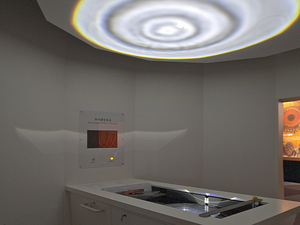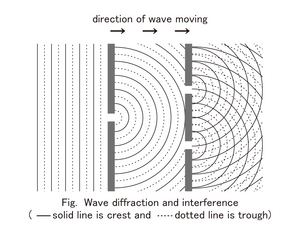Nagoya City Science Museum
TOP > Exhibition Guide > Keyword Search > Starting with "Y" > Young's Experiment > Observation of Wave Principle
Observation of Wave Principle



Purpose of Exhibition
This is a device to observe the characteristics of waves. It is possible to understand the phenomenon of waves overlapping and spreading.
Additional Knowledge
[Wave Diffraction]
Waves are carefully created with a horizontally positioned bar on the surface of the water. The waves are generated on a straight line parallel to the bar. Then, the water moves away from the bar and spreads over the surface. Then, a wall is placed in the path of the oncoming wave. There is a hole drilled in one place of the wall.
Most of the waves will stop at the wall. However, from the hole in the wall, the waves can reach the other side of the wall.
How do the waves continue once they pass through the hole? The waves continue until the wall in a straight line, and then from the hole, the waves spread around in circles.
The progression of those waves is called diffraction.
[Waves Interference]
Next, two holes are drilled in the wall. What will happen? The waves spread as if stones were thrown at two locations.
The waves emanating from the two locations will collide with each other. Then, the wave crests hit each other, becoming higher crests. When the wave troughs hit each other, they become deeper troughs. When the waves crests and troughs collide with each other, the waves disappear.
This can result in a regular surface wave, and is a phenomenon called interference.
[Wave Refraction]
We submerged a plate in part of the tank. Then only in that part, the water depth becomes deeper. When waves initiate from deep water depths, what phenomenon takes place?There are things like wave velocity that are transmitted to the waves. By nature, the wave's velocity is, the deeper, the faster; the more superficial, the slower.
If the wave movement direction is perpendicular to the edge of the submerged plate (level difference), because the waves roll on a superficial area, the velocity decreases and the distance between waves decreases. One can say that the wave's length has become shorter.
If the wave movement is diagonal to the edge of the submerged plate, because of the decreasing velocity, the direction of the waves changes. This phenomenon is called refraction.
[Sound and Light are Waves]
In this exhibition, we saw phenomena such as diffraction and interference of water waves. However, this does not concern only water waves, but these phenomena also occur with other waves, like the sound that is an air-wave and light that is an electromagnetic wave.
[Diffraction of Light and Sound]
If two people can talk standing in front of each other with a wall between them, it is because the sound has the capacity to diffract. If two people facing each other with a wall between them don't see each other, it is not because the light does not diffract, but because the wavelength is much shorter, and therefore diffraction occurs less. Diffraction is not enough for the wave to be seen on the other side of the wall.
However, if the waves are long wavelength light electromagnetic waves, even you are inside the mountains, because they can turn around mountains, (diffracting), you can still receive radio waves.
[Sound and Light Interference]
Interference between sound and light rarely becomes a reality in everyday life. However, it is easy to carry out an experiment.
If you generate the same sound from two speakers (sine waves are desirable) in a room when walking around the room, there are places where the sound is louder and other places where the tone is lower. This is due to the interference of the sound. In this exhibit waves are generated from holes in two places.
One experiment using light was carried out, and it became a historic experiment called the Young Experiment. Since Newton, it was believed that light was made of particles. Thomas Young showed the wave nature of light with this experiment.
[Refraction of Light and Sound]On a winter night, you can hear the sound of a distant train crossing a bridge. This is because the temperature of the air near the ground surface and on higher surfaces is different, and the velocity of the sound in the air differs according to the temperature. The movement direction is bent (refracted). The sound can be heard because after being sent into the sky, it returns down to earth.
Refraction of light can also be observed in everyday life. When putting chopsticks into a bowl, the curve that can be seen is called refraction.
Reflection of light is the phenomenon observed in a big bath, when the depth of the place away from oneself seems shallower.
Article by Yoshitaka Yamada, curator
